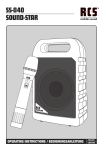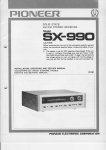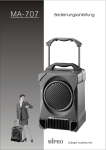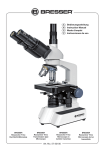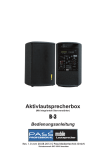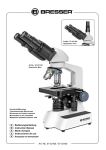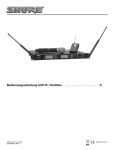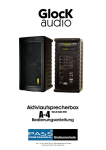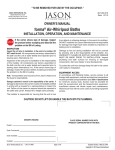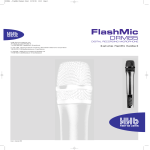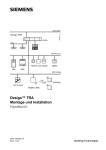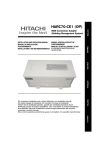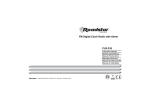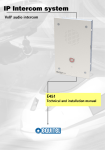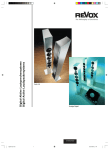Download Broschuere Sound Desk
Transcript
SD-120 SOUND-DESK OPERATING INSTRUCTIONS / BEDIENUNGSANLEITUNG - ENGLISH - DEUTSCH SOUND-DESK SAFETY INSTRUCTIONS SICHERHEITSHINWEISE Read all instruction before operating! 1. Install equipment as follow condition: • Install at flat place, not bending curved. • Do not install near the water and moisture. • Do not drop objects or spill liquids on to the inside of amplifier. • Locate power amplifier away from heat source. Vor Inbetriebnahme des Gerätes bitten wir Sie die Sicherheitshinweise aufmerksam zu lesen! 1. Installation nach folgenden Richtlinien: • Stellen Sie den Verstärker immer auf eine ebene und stabile Unterfläche. • Wählen sie eine trockene Umgebung und stellen sie keine Flüssigkeiten auf das Gerät. • Vermeiden Sie die Nähe von Heizungen und anderen Hitzequellen. 2. Keep in mind the following when connecting amplifier: • Connect the amplifier after reading of manuals. • Connect each connection of amplifier perfectly, if not, it maybe caused hum, damage, electric shock in case of misconnecting. • To prevent electric shock, do not open top cover. • Connect the power cord with safety after check of AC power. 2. Beachten Sie folgendes, wenn sie den Verstärker anschließen: • Lesen Sie zuerst die Betriebsanleitung • Öffnen sie niemals das Gehäuse des Gerätes ohne den Netzstecker zu ziehen. • Schließen Sie das Gerät nur an 230 V Netzspannung oder 12 V/DC Notstromversorgung an. RCS SOUND-SYSTEMS RCS SOUND-SYSTEME Thank you for choosing an RCS-portable sound system. Our products incorporate state-of-the-art design and the finest quality of materials and workmanship. We’re proud of our products and appreciate the confidence which you have shown by selecting an RCS system. I hope you’ll take a few minutes to review this manual. We’ve incorporated several unique features into our products and your knowledge of how to use them will enhance the performance and your enjoyment of the system. Vielen Dank, dass Sie sich für ein RCS-Beschallungssystem entschieden haben. Alle RCS-Systeme werden für grösstmögliche Mobilität und für höchste Ansprüche entwickelt und hergestellt. RCS-Mobil-Systeme sind leichtgewichtig und begleiten Sie dank ihrer kompakten Grösse überall hin. Mit leistungsstarken Verstärkern und wirkungsvollen Lautsprechersystemen kann jedes RCS-System Ihre individuellen Beschallungsprobleme in Innenräumen und im Freien lösen. Die gerätespezifischen Eigenschaften ermöglichen es, daß die Systeme sowohl für Musik wie auch für reine Sprachanwendung verwandt werden können. In weniger als 1 Minute Aufbauzeit ist fast jedes RCS-System einsatzbereit. INSPECTION AND INVENTORY OF YOUR SYSTEM AUSPACKEN UND KONTROLLE DES SYSTEMS Check unit carefully for damage which may have occurred during transit. Each RCS product is carefully inspected at the factory and packed in a special carton for safe transport. All damage claims must be made with the freight carrier. Notify the freight carrier immediately if you observe any damage to the shipping carton or product! Repack the unit in the carton and await inspection by the carrier’s claim agent. Notify your dealer of the pending freight claim. Returning your unit for service or repairs Should your unit require service, contact your dealer. Gerät senkrecht stellen und Deckkarton öffnen. In einem Beipack befindet sich evtl. Zubehör. Öffnen Sie nun den zweiten Karton an seiner Oberseite und ziehen Sie das Gerät nach oben am eingelassenen Griff heraus. Bitte überprüfen Sie das Gerät sofort auf evtl. Transportschäden. Alle Transportschäden müssen sofort bei der Transportfirma reklamiert werden! Rücksendung: Wenn es nötig sein sollte, ein defektes Gerät zurückzusenden, nehmen Sie bitte Kontakt mit Ihrem Händler auf. Bitte versenden sie alle Rücksendungen in der Originalverpackung. Electromagnetic compatibility and low-voltage guidelines: RCS leaves all devices and products, which are subject to the CE guidelines by certified test laboratories test. By the fact it is guaranteed that you may sell our devices in Germany and in the European Union domestic market without additional checks. Elektromagnetische Verträglichkeit und Niederspannungsrichtlinien: RCS läßt alle Geräte und Produkte, die den CE-Richtlinien unterliegen durch zertifizierte Prüflabors testen. Dadurch ist sichergestellt, daß Sie unsere Geräte in Deutschland und im EU-Binnenmarkt ohne zusätzliche Prüfungen verkaufen dürfen. 2 SOUND-DESK QUICK USE GUIDE KURZANLEITUNG CAUTION with battery-devices: Make sure that the batteries are fully charged before use. ACHTUNG bei Batteriegeräten: Laden Sie den Akku vor der ersten Benutzung immer erst vollständig auf. 1. Set the unit in front of your audience on the floor, table or on a speaker stand. Connect the plug of the mains cable to a mains socket (230 V~/ 50Hz). If you possess a battery version, the connection to the mains socket is not necessarily. 1. Positionieren Sie Ihr Lautsprechersystem mit oder ohne Stativ vor Ihrer Zuhörerschaft. Verbinden Sie das Netzkabel mit einer Netzsteckdose (230 V~/ 50Hz). Sollten Sie eine Akku-Version besitzen, ist die Verbindung mit dem Stromnetz nicht unbedingt erforderlich. 2. Plug a microphone into the MIC1/MIC2 input, or plug an audio source into the AUX/LINE input. 2. Schließen Sie ein Mikrophon an der MIC1/MIC2 Buchse, bzw. eine andere Tonquelle an der AUX IN-Buchse an. 3. Set all input level controls to minimum (left position), and set the bass and treble controls (TONE) to the mid-position. 3. Drehen Sie alle Volumen-Regler auf Minimum (nach links). Stellen Sie den Höhen- und Tiefenregler (TONE) auf mittlere Position. 4. Turn the power switch „ON“ (the main switch position is with nearly all RCS devices on the lower left side). The red LED light up. 4. Schalten Sie den Hauptschalter auf „ON“ (der Hauptschalter befindet sich bei fast allen RCS-Geräten auf der unteren linken Seite). Die rote LED leuchtet auf. 5. Slowly increase the level control adjacent to the input used until desired volume is reached. 5. Drehen Sie nun den VOLUMEN-Regler langsam nach rechts und steuern Sie so die richtige Lautstärke aus. 6. Adjust the bass and treble control (TONE) for desired sound quality. 6. Justieren Sie nun die Höhen- und Tiefenregler (TONE) auf die gewünschte optimale Wiedergabequalität ein. FEEDBACK INFORMATION INFORMATIONEN ÜBER RÜCKKOPPLUNG What causes feedback? Feedback is a ringing, howling, or shrill sound that is selfgenerated by the sound system. It is the result of sound from the speakers being picked up by the microphone(s) in use and then reamplified by the system. This can form a selfsustaining loop that can damage the sound system if allowed to continue. Was ist eine Rückkopplung ? Eine Rückkopplung ist ein pfeifender, schellender und sehr greller Ton, der sich selbst erregt. Befinden sich ein Mikrofon und ein Lautsprecher gleichzeitig in einem Raum, so besteht die Gefahr einer Rückkopplung. Die Voraussetzung für akustische Rückkopplung ist ein in sich geschlossener Übertragungskreis. Das Mikrofon nimmt ein Schallereignis auf, es wird verstärkt und vom Lautsprecher abgestrahlt; die Schallwellen des Lautsprechers treffen wieder auf das Mikrofon, werden weiter verstärkt und wiederum dem Lautsprecher zugeführt usw. How to prevent feedback? ALWAYS STAND BEHIND THE SPEAKER WHEN USING A MICROPHONE! Wie vermeide ich Rückkopplung? POSITIONIEREN SIE IHR MIKROFON WENN MÖGLICH IMMER HINTER DEN LAUTSPRECHERN! CAUTION: Feedback can damage your equipment and may be hazardous to your hearing! To avoid feedback, always make sure volume controls are at minimum before turning unit on. If feedback occurs, immediately reduce the volume. ACHTUNG: Ein durch Rückkopplung erzeugter Ton kann zur Zerstörung des Systems und zu Gehörschäden führen! Um eine Rückkopplung zu vermeiden, sollten Sie die Lautstärke bei Inbetriebnahme auf minimum stellen. Wenn Feedback auftritt, sollten Sie sofort die Lautstärke verringern. 3 SOUND-DESK REAR VIEW / RÜCKSEITE 1 3 2 8 4 5 9 10 6 11 7 12 13 20 14 15 16 17 18 19 21 4 SOUND-DESK OPERATING ELEMENTS AND CONNECTIONS BEDIENELEMENTE UND ANSCHLÜSSE 1. Goose-neck microphone 1. Schwanenhals-Mikrophon 2. Manuscript tray 2. Manuskript Ablage 3. Volume control for microphones: For optional wireless microphones MIC 1 & 2 (see point 4). 3. Lautstärkeregler für Mikrophone: Für optionale Drahtlosmikrophone MIC 1 & 2 (siehe Punkt 4). 4. Recieption LED: Light up when a signal is received from the wireless microphone. 4. Empfangsanzeige: Leuchtet beim Empfang eines Signals vom Drahtlosmikrophon. 5. Volume control for the lectern microphone 5. Lautstärkeregler für das Rednerpult-Mikrophon 6. Volume control for wire-microphone 6. Lautstärkeregler f. Drahtgebundene-Mikrofone 7. AUX volume controller 7. Lautstärkeregler für AUX-IN 8. Tone controller: To adjust the TREBEL and BASS parts. 8. Klangregler: Zur Einstellung der Höhen- und Tiefenanteile 9. Input for wire-microphones 9. Eingangsbuchsen Drahtgebundene-Mikrofone 10. AUX IN (Auxiliary signal input -22dB 600Ohm): To connect a external audio source. 10. Eingangsbuchse AUX (Signal -22dB 600Ohm): Zum Anschluß einer externen Tonquelle. 11. LINE-OUT 1: For the connection of an additional loudspeaker, recording equipment or amplifier (signal output 0dB 600 Ohm) 11. Ausgangsbuchse LINE-OUT 1: Zum Anschluß eines Zusatz-Lautsprechers, eines Aufnahmegeräts oder eines Verstärkers (Signalausgang 0dB 600 Ohm). 12. LINE-OUT 2: For the connection of further additional loudspeakers, recording equipment or amplifier (signal output 0dB 600 Ohm) 12. Ausgangsbuchse LINE-OUT 2: Zum Anschluß eines weiteren Zusatz-Lautsprechers, eines Aufnahmegerätes oder Verstärkers (Signalausgang 0dB 600 Ohm). 13. Sensitivity controller for tablemic: (controllers are at the desk lower side) 13. Empfindlichkeitsregler Rednerpult-Mikrophon: (Regler befinden sich an der Pultunterseite) 14. DC low voltage fuse: Replace a blown fuse by one of the same type only. 14. DC Kleinspannungssicherung: Durchgebrannte Sicherung nur mit einer gleichen Typs ersetzen. 15. DC low voltage jack: to connect the unit to an external DC supply (max. 18 V) for a long-term use battery operation. 15. DC Kleinspannungsbuchse: zum Anschluß an eine externe Gleichstromversorgung (max. 18 V) für den Langzeit Batterie-Betrieb. 16. Power, charge & charge battery indicator: The red LED light up during sufficiently internal voltage supply. If the yellow LED flash the built-in charging battery is weak – please recharge it. The green LED illuminate during the charging process. 16. Spannungs-, Lade- & Akku-Zustandsanzeige: Die rote LED leuchtet bei ausreichend interner Spannungsversorgung. Leuchtet die gelbe LED, ist der Akku zu schwach und muss wieder aufgeladen werden. Die Gürne LED leuchtet während des Ladevorgangs. 17. Power- and Charge-switch Press: left = ON; middle = OFF; right = CHARGE 18. AC-Power plug to connect to 230 V~/50 Hz 19. AC fuse: Replace a blown fuse by one of the same type only ( 220V – 240V-2 A). 20. ALU/ABS Case: Housing the aktive Loudspeakersystem contains 4 Loudspeakers. 21. Stand: With four heigth adjustable stand-screws. 17. Netz- und Lade-Schalter: Links = EIN; mitte = „AUS“; rechts = LADEN 18. AC Netzstecker zum Anschluß an 230 V~/50 Hz 19. AC Netzsicherung: Durchgebrannte Sicherung nur mit einer gleichen Typs (SI-220 – 240V-2 A) ersetzen. 20. ALU/ABS Gehäuse: Beherbergt das Aktive-Lautsprechersystem mit 4 Lautsprechen. 21. Standfuß mit 4 höhenverstellbaren Standschrauben. 5 SOUND-DESK OPTION WH-800: HANDHELD WIRELESS MICROPHONE / DRAHTLOSES HANDMIKROPHON 1 3 2 5 6 4 7 8 WH-800 FEATURES WH-800 EIGENSCHAFTEN This Microphone incorporates ,,Noise-Lock“ dual-squelch circuitry to reduce interference. Das Mikrofon verfügt über einen Doppel-Squelch Schaltkreis mit Pilotton für höchste Übertragungssicherheit. The optional handheld wireless microphone WH-800 is modular in design. Das drahtlose Handmikrofon WH-800 ist modular aufgebaut und besteht aus folgenden Komponenten: 1. Grille: Protects the microphone capsule and is additionally with an integrated wind-protection against „POP“ noises. 1. Schutzgitter: Schützt die Mikrofonkapsel und ist zusätzlich mit einem integrierten Windschutz gegen „POP“-Geräusche versehen. 2. Anti-Rolling colored-ring: For frequency identification. lts polygonal shape also prevents the microphone from rolling when placed on a flat surface. 2. Anti-Roll Kennungsring: Zur Identifikation des Mikrofons in verschiedenen Farben erhältlich. Zudem verhindert die Form des Ringes, dass das Mikrofon wegrollt. 3. Microphone capsule: The high-fidelity condenser microphone capsule is ideal for spech and vocals. 3. Mikrofonkapsel: Die hochwertige Kondensatorkapsel mit hoher Wiedergabefähigkeit ist ideal für Sprache und Gesang. 4. Housing with transmitting unit: The housing is provided with a special coating, which dams hand noises. Upper section is connected at capsule module. lnternally, it houses the transmitter PCB and battery compartment. 4. Gehäuse mit Sendeteil: Das Gehäuse ist mit einer Spezialbeschichtung versehen, welche Handgeräusche dämmt. An der Oberseite ist es mit der Mikrophonkapsel verbunden. Innen beherbergt es die Sende-Elektronik und das Batteriefach. 5. Battery Status indicator: Display power and battery status. When the power switch is turned ON, the red LED flashes briefly, indicating normal battery status. If after power and the indicator stays lighted, it warns that the battery is weak and should be replaced. 5. Batterieanzeige: Spannungs- und Batteriestatus-Anzeige. Beim Einschalten blitzt die rote LED kurz auf und zeigt normalen Batteriezustand an. Leuchtet die Anzeige permanent, ist die Batterie schwach und sollte ausgewechselt werden. 6. Power switch: Turn the microphone ON or OFF 6. EIN-/AUS-Schalter: Schaltet das Mikrofon EIN bzw. AUS. 7. Battery compartment: Designed to accommodate one 9V battery or a 7,2V Akku. 7. Batteriefach: Zur Verwendung eines 7,2 V Akkus oder einer handelsüblichen 9Volt Batterie. 8. Battery Cap (s. battery installation) 8. Batterie-Deckel (s. Batterie auswechseln) 6 SOUND-DESK OPTION WH-800 OPERATING INSTRUCTIONS WH-800 BEDIENUNGSHINWEISE As the microphone is switched on: When the power is switched ON, the indicator will flash briefly indicating normal operation. Einschalten des Mikrofons: Beim Einschalten leuchtet die Batterieanzeige kurz auf. Leuchtet die LED permanent muss die Batterie ersetzt werden. During Usage – if you work with the… Während des Gebrauchs, wenn sie den… … internal SOUND-DESK UHF-Receiver: The green indicator beside the Volume controller (MIC1) light up green if the receiving status is optimal and the signal strength is really good. … internen SOUND-DESK UHF-Empfänger benutzen: Das grüne Lämpchen neben dem Lautstärkeregler (MIC1) leuchtet auf wenn der Sender eingeschaltet ist und ein ausreichendes Empfangssignal aufgebaut wurde. … external UHF-Receiver (RU-800): The SIGNAL LED indicator on the receiver glows. The more LEDs that glow indicate that the received signal strength is stronger. If the red LED illuminates it indicates abnormal receiving status and insufficient signal strength. … externen UHF-Empfänger (RU-800) benutzen: Die SIGNAL-LED‘s am Empfänger leuchten grün auf. Je mehr Lämpchen aufleuchten, desto besser ist die Empfangsstärke. Wenn nur die rote LED leuchtet, signalisert dies eine anormale bzw. eine zu niedrige Empfangsstärke. The AUDIO LED indicator on the receiver will illuminate according to the audio signal strength from the microphone (Level of 1 - 2 LEDs with normal speech usage). When the red LED light up, it indicates that maximum sound pressure level has been reached, but it does not represent distortion. Die AUDIO-LED‘s am Empfänger leuchten entsprechend der Audiosignalstärke wenn in das Mikrophon gesprochen wird (Ausschlagpegel von 1 bis 2 Lämpchen bei normalem Sprachgebrauch). Wenn die rote LED aufleuchtet, ist der maximale Schalldruckpegel erreicht worden (diese LED zeigt nicht Verzerrung an). When the microphone is not in use: Make sure that you turn off the microphone after use to extend the battery life. Remove the battery from the battery compartment if microphone is not be used for a while. If a rechargeable battery was used, take it out and recharge it. Wenn das Mikrofon nicht gebraucht wird… Vergewissern Sie sich, dass das Mikrofon ausgeschaltet ist, da ansonsten die Batterie verbraucht wird. Nehmen Sie die Batterie aus dem Batteriefach, wenn Sie das Mikrofon längere Zeit nicht einsetzen. Wenn sie einen Akku verwenden, können Sie diesen entnehmen und wieder aufladen. BATTERY INSTALLATION BATTERIE EINLEGEN Unscrew battery cap in a counter-clockwise direction. Insert a 9-V battery into the battery compartment according to the correct polarity. The moment the battery touches the terminals, the indicator will flash briefly. This means the polarity is correct. However, if a flash occurs, this indicates wrong insertion or that the battery is weak. Please re-insert the battery according to its correct polarity or exchange it for a fresh battery. Schrauben Sie den Batteriedeckel durch drehen gegen denUhrzeigersinn ab. Setzen Sie einen Akku (7.2 Volt) oder eine 9 Volt Batterie ein. Achten Sie dabei auf die korrekte Polariät (+/–). Danach Batteriedeckel wieder zuschrauben. Die Baterieanzeige sollte nun beim Einschalten kurz aufleuchten. Ist dies nicht der Fall, ist eventuell die Polarität falsch oder die Batterie leer. Legen sie dann die Batterie erneut mit der korrekten Polarität ein bzw. eine neue Batterie. 7 SOUND-DESK OPTION WB-800: BODYPACK / TASCHENSENDER 1 2 3 4 5 6 7 10 8 9 10 WB-800 BODYPACK (TRANSMITTER) TASCHENSENDER WB-800 1. Transmitting Antenna: 1/4λ Transmitting antenna. In usage it should be freely as possible. 1. Sende-Antenne: 1/4λ Antenne, die beim Betrieb möchlichst frei stehen sollte. 2. Battery Status indicator: The LED flashes briefly, indicating normal battery status. If the red LED indicator stays lighted, the battery is weak and should be replaced. 2. Batterieanzeige: Leuchtet nur kurz beim Einschalten. Leuchtet permanent, wenn die Batterie gewechselt werden sollte. 3. Power Switch: Turn the transmitter and the microphone ON or OFF. 3. EIN-/AUS-Schalter: Schaltet die Spannungsversorgung des Senders und Mikrofons EIN bzw. AUS. 4. AF Input Jack: For the connection of Lavalier microphone, headset or guitar. 4. 4-Pin Mini XLR-Stecker: Zum Anschluss von einem Lavalier- u. Kopfbügel-Mikrofon oder einer Gitarre. 5. ABS Transmitter Housing 5. ABS Gehäuse 6. Frequency group 6. Frequenzcode 7. Gain Control: Adjusts the desirous input gain (see 8). 7. Regler für Eingangsempfindlichkeit: Zum justiert der gewünschten Sensibilität (siehe 8). 8. GT/MT Level Select Switch: Switch GT position for electric guitar usage ONLY. Gain Control is irrelevant for ,,GT“. Switch to ,,MT‘ for condenser microphone, wired microphone. Recommended is rather a small adjustment, in order to avoid feedbacks and over-regulation. Adjust the optimal volume at the receiver.. 8. GT-/MT-Schalter: Steht der Schalter auf GT, so ist der Eingang auf eine E-Gitarre abgestimmt. Auf MT kann die Eingangsempfindlichkeit am kleinen Poti neben dem Schalter verändert werden. Empfohlen ist eher eine geringe Einstellung, um Rückkopplungen und Übersteuerung zu vermeiden. Steuern Sie die optimale Lautstärke am Empfänger aus. 9. Transmitter Housing (transmitter electronic) 10. Battery Compartment 11. Detachable Belt Clip: Pull arrow direction at release 8 9. Sendergehäuse (Sendeelektronik) 10. Batteriefach 11. Abnehmbare Gurtklammer: Drehbar zur optimalen Positionierung. SOUND-DESK OPTION Plug the microphone connector into the XLR-input jack and tighten the connecter screw by clockwise direction as Shawn. Stecken Sie das Mikrofon an den 4Pin-XLR-Steckers des Taschensenders. Achten Sie dabei auf die korrekte Position des. Fixieren Sie den Stecker anschließend durch schrauben im Uhrzeigersinn wie abgebildet. Topview input connector Draufsicht Gerätestecker Technical information about input-Pins: 1 = 2-Wire Electret condenser microphone Capsule 2 = 3-Wire Electret condenser microphone Capsule 3 = Dynamic Microphone 4 = Electric Guitar 5 = Line-in (Impedance 8K ATT. 10dB; AF 4-Pin Input) Technische Information zur Pin-Belegung: 1 = 2-Draht Electret Kondensatormikrophone 2 = 3-Draht Electret Kondensatormikrophone 3 = Dynamisches Mikrophone 4 = 1-Draht-Gitarrenanschluß 5 = AUX / Line-Pegel (Impedanz 8K-Ohm ATT. 10dB; AF 4-Pin Eingang) BATTERY INSTALLATION BATTERIE EINLEGEN Pushing down both snatches on the sides of battery cover to open it and proceed as shown underneath. Insert a 9V battery into the battery compartment according at the correct polarity as shown. Then push up to dose the battery compartment as shown. The LED indicator flashes briefly when power on indicating normal battery status. If an flash occurs it has either no battery, the battery is drained or installed incorrectly. Change accordingly. Öffnen Sie den Batteriefachdeckel mit leichtem Druck auf die seitlich angebrachten Griffe und gehen sie wie unten abgebildet vor. Setzen Sie einen Akku (7.2 Volt) oder eine 9 Volt Batterie ein. Achten Sie dabei auf die korrekte Polariät (+/–). Danach Batteriedeckel wieder zuschrauben. Die Batterieanzeige sollte nun beim Einschalten kurz aufleuchten. Ist dies nicht der Fall, ist eventuell die Polarität falsch oder die Batterie leer. Legen sie dann die Batterie erneut mit der korrekten Polarität ein bzw. eine neue Batterie. (Einige wenige Batteriemarken sind nicht kompatibel zum RCS Taschensender!) 9 SOUND-DESK OPTION ADDITIONAL ACTIVE-SPEAKER SR-120 ZUSATZ-AKTIVLAUTSPRECHER SR-120 The SR-120 is the speaker sound system to compliment the SOUND DESK. This active sound system together with the SOUND-DESK enables users to reach an audience of boundless capacities. The Bridge Technology makes it simple to connect the systems. The impressive construction of the SR-120 ensures high-fidelity. Obviously you can use the UHF technology System to create wireless networks. Diese, speziell auf die Technik des SOUND-DESK abgestimmten, Aktiv-Zusatzlautsprecher sind als optimale Ergänzung zum SOUND-DESK erhältlich. Mit diesen Zusatzlautsprechern erzielen Sie selbst in größten Örtlichkeiten optimale Ergebnisse. Mit der Bridge-Technik ist es kinderleicht, die Systeme miteinander zu koppeln. Selbstverständlich können Sie mit Hilfe der UHF-Technik ganze drahtlose Netzwerke mit diesem System aufbauen. SETTING METHOD OF TRIPOD STATIV AUFSTELLEN • First ensure the tripod is situated on a stable grounding. • • Lift the laudspeaker onto the tripod and secure speaker firmly in place Stellen Sie die Füße des Stativs auf einen sicheren und rutschfesten Untergrund. • Setzen Sie den Lautsprecher auf das Stativ. • Greifen Sie mit der einen Hand das Rohr unter der Lautsprecherbox und mit der anderen die Rohrschelle. Justieren Sie, durch verschieben des Auszugsrohrs, die optimale Höhe für den Lautsprecher. • Sorgen Sie durch Anziehen der Rohrschelle für einen sicheren Sitz. • Adjust to proper height and then secure the srews. Seize with one hand the pipe under the loudspeaker box and with the other one the pipe clamp. Adjust through shift the extension pipe the desired height for the loudspeaker. • Provide by tightening the pipe clamp for a safety stand. 10 SOUND-DESK TECHNICAL SPECIFICATIONS SD-120 Power AC: 110 V/120 V or 220 V/240 V, 50/60 Hz Power DC: rechargeable battery 12 V – 18 V Ouput Power: 60/120 Watt Microphone: high quality 55 cm / goose-neck Input - MIC: 2 x MIC with LED-Indicator for wireless systems Input - AUX: -22 dBV / 600 Ohm Output: 0 dB / 600 Ohm Output/Input - Bridge: IN -12 dB 50K / OUT -12 dBV 600 K Frequency range/Distortion: 90 Hz ~ 15.000 KHz; ±3 dB Tone control: single EQ Loudspeaker: 4 x 30 Watt Broadband Receiver system: UHF: E= 863,3 MHz; F = 863,9 MHz; G = 864,8 MHz Options: UHF-Wireless, Tripod, Additional Active-Speakers and div. microphones Chargertime: 10~12 hours Outside material: ALU; ABS Dimensions (WxHxD): 550 x 1080 x 432 mm Weight: 21,5 kg *Specifications subject to change without notice. 11 SOUND-DESK RCS27.07.2005 © Copyright by RCS AUDIO-SYSTEMS GmbH. Publication and duplication of the contained data only allowed with our strict permission. Veröffentlichung und Vervielfältigung der enthaltenen Daten, auch auszugsweise, nur mit unserer ausdrücklichen Genehmigung.












